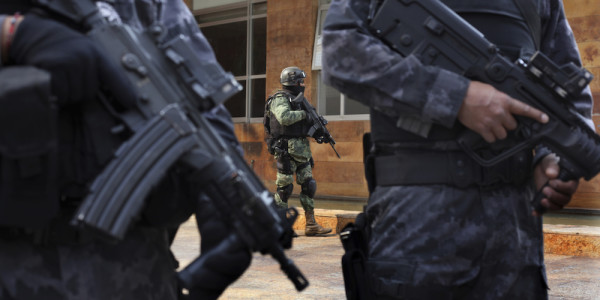

After six years of civil war, Syria remains the bloodiest battlefield on the planet. But there’s one other conflict zone whose violence in recent years has come to eclipse both the wars in Iraq and Afghanistan — and the bloodshed is right on America’s doorstep.
Thanks to the rising tide of cartel violence, Mexico surpassed Iraq and Afghanistan to become the world’s second-deadliest war zone in 2016, according to the annual Armed Conflict Survey by the International Institute for Strategic Studies.
The reign of terror wrought upon innocent civilians by Mexico’s drug cartels accounted for 23,000 fatalities in 2016, according to IISS’s study of ongoing conflicts around the world. That’s compared with around 16,000 deaths in Iraq and 17,000 in Afghanistan. (All three pale in comparison to the sixth year of the Syrian civil war, which took more than 50,000 lives last year.)
The rise of cartel violence in Mexico isn’t surprising: Bloodied bodies turn up on the local news on a seemingly regular basis, usually as a warning to journalists and law enforcement to keep their distance.
But compared with the conflict zones in Iraq, Afghanistan, and Syria, Mexico is a bit of an outlier in one key respect. Bloomberg reports:
“Mexico is a conflict marked by the absence of artillery, tanks or combat aviation,” IISS director general John Chipman said in remarks at the survey’s launch in London on Tuesday. Virtually all of those deaths were caused by small arms.
The largest number of fatalities occurred in Mexican states that have become “key battlegrounds for control between competing, increasingly fragmented cartels,” he said, with violence flaring as gangs try to clear areas of rivals so they can monopolize drug trafficking routes.
According to the Department of State, at least 163 Americans were killed in Mexico between December 2014 and December 2016 — that’s only including deaths that State officially classified as homicides.
Since December, the State Department has maintained a travel warning for travelers to Mexico, stating that “gun battles between rival criminal organizations or with Mexican authorities have taken place on streets and in public places during broad daylight,” while “U.S. citizens have been the victims of violent crimes, including homicide, kidnapping, carjacking, and robbery in various Mexican states.”
The irony, of course, is that the conflict raging just below America’s southern border often spills over onto American soil.
And that’s not just because of heroin, which killed more Americans than guns in 2015: According to the Drug Enforcement Agency’s 2016 National Drug Threat Assessment, Mexican cartels “work with smaller local criminal groups and gangs across the United States for retail drug distribution and transportation” in major cities like Chicago, Boston, and Washington.
Though the cartels’ U.S. associates generally “refrain from inter-cartel violence that accounts for the high fatality rate in 2016 to avoid police scrutiny,” it’s their ambitions and vendettas that are increasingly accounting for growing gang violence across the U.S., according to the DEA.
It’s no surprise that the cartels have turned our southern neighbor into a battlefield on par with Iraq and Afghanistan. But the problem Mexico poses for the U.S. is similar to that posed by our faraway battlefields: What can America do to stop the violence, much less prevent its spread domestically?
WATCH NEXT:
